A Geo-Hazard Risk Assessment Technique for Analyzing Impacts of Surface Subsidence within Onyeama Mine, South East Nigeria
Abstract
1. Introduction
2. The Study Area
3. Methodology
3.1. Preparation of the Data
3.2. SBAS-DInSAR Processing Technique
3.3. The Geo-Hazard Risk Assessment Technique
3.3.1. Horizontal Deformation and Vertical Subsidence Risk Assessment
- i.
- Calculate the summary of minimum, maximum, and average forecasted or predicted horizontal deformation and vertical subsidence across the fourteen investigation locations from 2021 to 2024. Use it to rank the scale of likelihood.
- ii.
- The scale of likelihood is ranked: Minimum = Not Likely; Average = Possible; Maximum = Probable.
- iii.
- Calculate the summary of minimum, maximum, and average original or processed horizontal deformation and vertical subsidence across the fourteen investigation locations from 2016 to 2020. Use it to rank the scale of severity.
- iv.
- The scale of severity is ranked: Minimum = Acceptable; Average = Tolerable; Maximum = Generally Unacceptable.
- v.
- Design the risk assessment matrix based on the scale of likelihood and scale of severity.
- vi.
- Summarize the level of risk as Low, Medium, and High by matching the scale of severity against the scale of likelihood.
3.3.2. Vulnerability Assessment
- i.
- Physical dimension: Physical properties that are likely to be affected include physical infrastructures such as roads, built-up environments, utilities, and open spaces.
- ii.
- Social dimension: This is specific to the people or organizations in the social system that may be exposed to disaster.
- iii.
- Institutional dimension: This includes governance and organizational structures, formal legal process, operations and directions, as well as informal customary laws, which may be affected by a disaster.
- iv.
- Environmental dimension: This involves the general ecosystem (ecological and biophysical processes) that may be degraded and polluted in the event of a disaster.
- v.
- Economic dimension: This refers to the destruction of production capacity and economic losses to people in the event of a disaster.
- vi.
- Cultural dimension: This refers to the damaging impacts of disasters on beliefs and value systems.
3.3.3. Mapping the Elements at Risk
4. Results
4.1. Horizontal Deformation and Vertical Subsidence
4.2. Geo-Hazard Risk Assessment Results for Horizontal Deformation
4.3. Geo-Hazard Risk Assessment Results for Vertical Subsidence
4.4. Vulnerability Assessment Results
5. Discussion
6. Conclusions
Author Contributions
Funding
Institutional Review Board Statement
Informed Consent Statement
Data Availability Statement
Conflicts of Interest
References
- Van Westen, C.J. Remote sensing and GIS for natural hazards assessment and disaster risk management cees. Treatise Geomorphol. 2013, 3, 259–298. [Google Scholar]
- Zhang, J.; Wang, J.; Chen, S.; Tang, S.; Zhao, W. Multi-hazard meteorological disaster risk assessment for agriculture based on historical disaster data in Jilin Province, China. Sustainability 2022, 14, 7482. [Google Scholar] [CrossRef]
- Cian, F.; Delgado, M.; Carrera, L. Sentinel-1 for monitoring land subsidence of coastal cities in africa using PSInSAR: A methodology based on the integration of SNAP and staMPS. Geosciences 2019, 9, 124. [Google Scholar] [CrossRef]
- Fahim, A.U. Natural disaster risk assessment in the coastal area of Bangladesh: A case study on Cox ’s Bazar Paurashava. Bauet J. 2021, 3, 28–42. [Google Scholar]
- Ezemokwe, I. Environmental impact assessment of Onyeama coal mine in Enugu, Southeastern Nigeria. Impact Assess. Proj. Apprais. 2018, 33, 73–79. [Google Scholar]
- Grassi, F.; Mancini, F. Sentinel-1 data for ground subsidence monitoring: The SNAP-StaMPS workflow. In Proceedings of the 12 Workshop Tematico di Telerilevamento, Bologna, Italy, 25–25 July 2019. [Google Scholar]
- Di Martire, D.; Tessitore, S.; Brancato, D.; Ciminelli, M.G.; Costabile, S.; Costantini, M.; Graziano, G.V.; Minati, F.; Ramondini, M.; Calcaterra, D. Landslide detection integrated system (LaDIS) based on in-situ and satellite SAR interferometry measurements. Catena 2016, 137, 406–421. [Google Scholar] [CrossRef]
- Igwe, O.; John, U.I.; Solomon, O.; Obinna, O. GIS-based gully erosion susceptibility modeling, adapting bivariate statistical method and AHP approach in Gombe town and environs Northeast Nigeria. Geoenviron. Disasters 2020, 7, 1–16. [Google Scholar] [CrossRef]
- Nduji, N.N.; Madu, C.N.; Okafor, C.C. A low-cost web application system for monitoring geometrical impacts of surface subsidence. Sustainability 2022, 14, 14240. [Google Scholar] [CrossRef]
- Ghorbanzadeh, O.; Rostamzadeh, H.; Blaschke, T.; Gholaminia, K.; Aryal, J. A new GIS-based data mining technique using an adaptive neuro-fuzzy inference system (ANFIS) and k-fold cross-validation approach for land subsidence susceptibility mapping. Nat. Hazards 2018, 94, 497–517. [Google Scholar] [CrossRef]
- Ghorbanzadeh, O.; Valizadeh Kamran, K.; Blaschke, T.; Aryal, J.; Naboureh, A.; Einali, J.; Bian, J. Spatial prediction of wildfire susceptibility using field survey GPS data and machine learning approaches. Fire 2019, 2, 43. [Google Scholar] [CrossRef]
- Zlateva, P.; Hristozov, S.; Velev, D. A fuzzy logic approach for drone capability analysis on disaster risk assessment. Int. Arch. Photogramm. Remote Sens. Spat. Inf. Sci. 2019, 42, 485–489. [Google Scholar] [CrossRef]
- Ramli, M.W.A.; Alias, N.E.; Mohd Yusof, H.; Yusop, Z.; Taib, S.M. Development of a local, integrated disaster risk assessment framework for malaysia. Sustainability 2021, 13, 10792. [Google Scholar] [CrossRef]
- Simmons, D.C.; Corbane, C.; Menoni, S.; Schneiderbauer, S.; Zschau, L. Understanding Disaster Risk: Risk Assessment Methodologies and Examples. In Science for Disaster Risk Management 2017: Knowing Better and Losing Less; Publications Office of the European Union: Rome, Italy, 2017; pp. 38–130. Available online: https://drmkc.jrc.ec.europa.eu/portals/0/Knowledge/ScienceforDRM/ch02/ch02.pdf (accessed on 21 January 2023).
- Radtke, K.; Day, J.; Forster, T.; Himmelsbach, J.; Korte, L.; Mucke, P. World Risk Report 2019 Focus: Water Supply. Available online: https://reliefweb.int/sites/reliefweb.int/files/resources/WorldRiskReport2019_Online_english.pdf (accessed on 10 January 2023).
- Ayeb-Karlsson, S.; Kniveton, D.; Cannon, T.; van der Geest, K.; Ahmed, I.; Derrington, E.M.; Florano, E.; Opondo, D.O. I will not go, I cannot go: Cultural and social limitations of disaster preparedness in Asia, Africa, and Oceania. Disasters 2019, 43, 752–770. [Google Scholar] [CrossRef] [PubMed]
- Moreira, L.L.; de Brito, M.M.; Kobiyama, M. Review article: A systematic review and future prospects of flood vulnerability indices. Nat. Hazards Earth Syst. Sci. 2021, 21, 1513–1530. [Google Scholar] [CrossRef]
- Komendantova, N.; Mrzyglocki, R.; Mignan, A.; Khazai, B.; Wenzel, F.; Patt, A.; Fleming, K. Multi-hazard and multi-risk decision-support tools as a part of participatory risk governance: Feedback from civil protection. Int. J. Disaster Risk Reduct. 2014, 8, 50–67. [Google Scholar] [CrossRef]
- Birkmann, J.; Cardona, O.D.; Carreño, M.L.; Barbat, A.H.; Pelling, M.; Schneiderbauer, S.; Kienberger, S.; Keiler, M.; Alexander, D.; Zeil, P.; et al. Theoretical and Conceptual Framework for the Assessment of Vulnerability to Natural Hazards and Climate Change in Europe: The MOVE Framework. In Assessment of Vulnerability to Natural Hazards: A European Perspective; Elsevier: Amsterdam, The Netherlands, 2014; pp. 1–19. [Google Scholar]
- Wu, Z.; Lv, H.; Meng, Y.; Guan, X.; Zang, Y. The determination of flood damage curve in areas lacking disaster data based on the optimization principle of variation coefficient and beta distribution. Sci. Total Environ. 2021, 750, 142277. [Google Scholar] [CrossRef]
- Tate, E. Social vulnerability indices: A comparative assessment using uncertainty and sensitivity analysis. Nat. Hazards 2012, 63, 325–347. [Google Scholar] [CrossRef]
- Sullivan-Wiley, K.A.; Short Gianotti, A.G. Risk Perception in a Multi-Hazard Environment. World Dev. 2017, 97, 138–152. [Google Scholar] [CrossRef]
- Papathoma-köhle, M.; Cristofari, G.; Wenk, M.; Fuchs, S. The importance of indicator weights for vulnerability indices and implications for decision making in disaster management. Int. J. Disaster Risk Reduct. 2019, 36, 101103. [Google Scholar] [CrossRef]
- Zaki, R.; Bulgiba, A.; Nordin, N.; Ismail, N.A. A systematic review of statistical methods used to test for reliability of medical instruments measuring continuous variables. Iran. J. Basic Med. Sci. 2013, 16, 803. Available online: http:///pmc/articles/PMC3758037/ (accessed on 10 January 2023).
- Medina, N.; Abebe, Y.A.; Sanchez, A.; Vojinovic, Z. Assessing socioeconomic vulnerability after a hurricane: A combined use of an index-based approach and principal components analysis. Sustainability 2020, 12, 1452. [Google Scholar] [CrossRef]
- Salufu, S.O. Integrated Study of Acid mine drainage and its environmental effects on Onyeama mine and its environment. J. Multidiscip. Eng. Sci. Technol. 2014, 1, 7–12. [Google Scholar]
- Raspini, F.; Bianchini, S.; Ciampalini, A.; Del Soldato, M.; Solari, L.; Novali, F.; Del Conte, S.; Rucci, A.; Ferretti, A.; Casagli, N. Continuous, semi-automatic monitoring of ground subsidence using Sentinel-1 satellites. Sci. Rep. 2018, 8, 7253. [Google Scholar] [CrossRef] [PubMed]
- Casu, F.; Elefante, S.; Imperatore, P.; Zinno, I.; Manunta, M. SBAS-DInSAR parallel processing for subsidence time-series computation. IEEE J. Sel. Top. Appl. Earth Obs. Remote Sens. 2014, 7, 3285–3296. [Google Scholar] [CrossRef]
- De Luca, C.; Cuccu, R.; Elefante, S.; Zinno, I.; Manunta, M.; Casola, V.; Rivolta, G.; Lanari, R.; Casu, F. an on-demand web tool for the unsupervised retrieval of earth’s surface subsidence from SAR data: The P-SBAS service within the ESA G-POD environment. Remote Sens. 2015, 7, 15630–15650. [Google Scholar] [CrossRef]
- Gallina, V.; Torresan, S.; Critto, A.; Sperotto, A.; Glade, T.; Marcomini, A. A review of multi-risk methodologies for natural hazards: Consequences and challenges for a climate change impact assessment. J. Environ. Manag. 2016, 168, 123–132. Available online: https://www.sciencedirect.com/science/article/pii/S0301479715303650 (accessed on 10 January 2023). [CrossRef]
- UNISDR. National Disaster Risk Assessment: Governance System, Methodologies, and Use of Results; Consultati; Safaie, S., Ed.; United Nation Office for Disaster Risk Reduction (UNISDR): Geneva, Switzerland, 2017; pp. 1–81. [Google Scholar]
- Sharma, A.; Miyazaki, H. Multi-hazard risk assessment in urban planning and development using AHP. Int. Arch. Photogramm. Remote Sens. Spat. Inf. Sci. 2019, 42, 363–371. [Google Scholar] [CrossRef]
- Chen, Y.; Wang, K. Accuracy verification and evaluation of Sentinel-1A repeat track differential interferometric synthetic aperture radar in monitoring mining subsidence. J. Appl. Remote Sens. 2021, 14, 014501. [Google Scholar] [CrossRef]
- Ge, L.; Rizos, C.; Han, S.; Zebker, H. Mining subsidence monitoring using the combined insar and gps approach. In Proceedings of the 10th International Symposium on Subsidence Measurements, Orange, CA, USA, 19–22 March 2001; pp. 1–10. [Google Scholar]
- Nguyen, K.A.; Liou, Y.A.; Terry, J.P. Vulnerability of Vietnam to typhoons: A spatial assessment based on hazards, exposure and adaptive capacity. Sci. Total Environ. 2019, 682, 31–46. [Google Scholar] [CrossRef]
- Owczarz, K. A review of geodetic and remote sensing methods used for detecting surface displacements caused by mining. IOP Conf. Ser. Earth Environ. Sci. 2020, 609, 012076. [Google Scholar] [CrossRef]
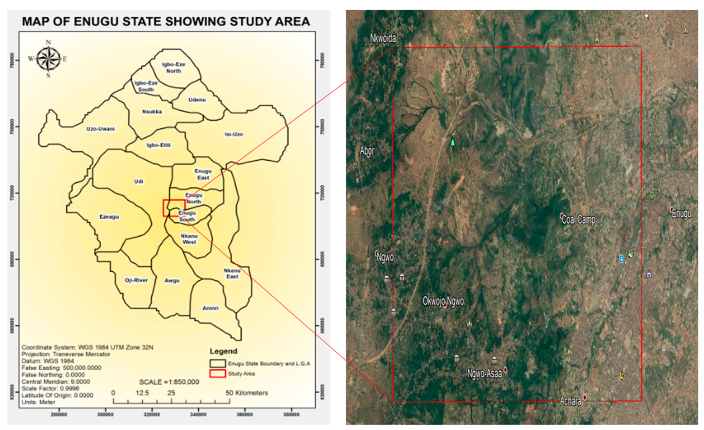
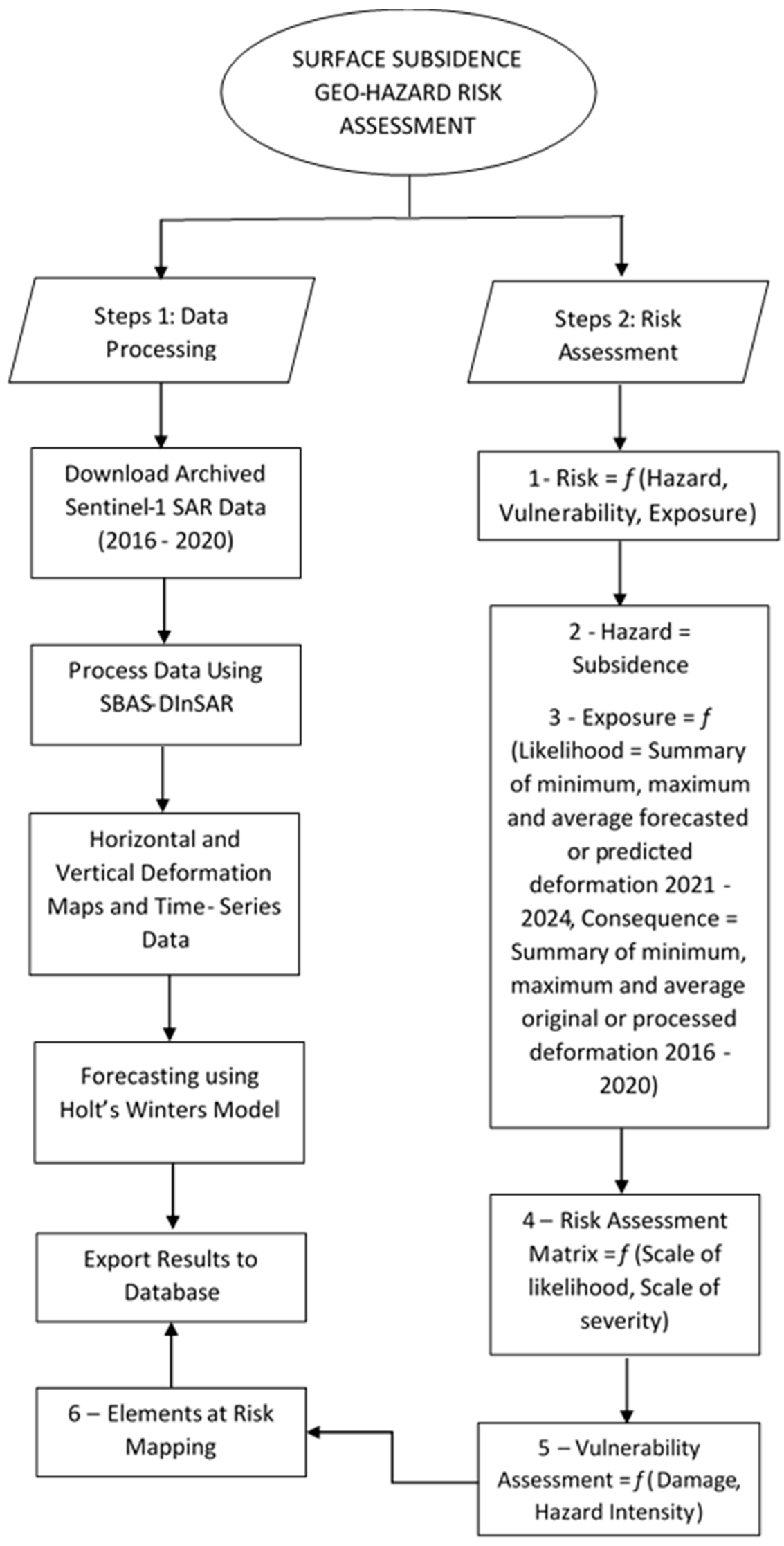

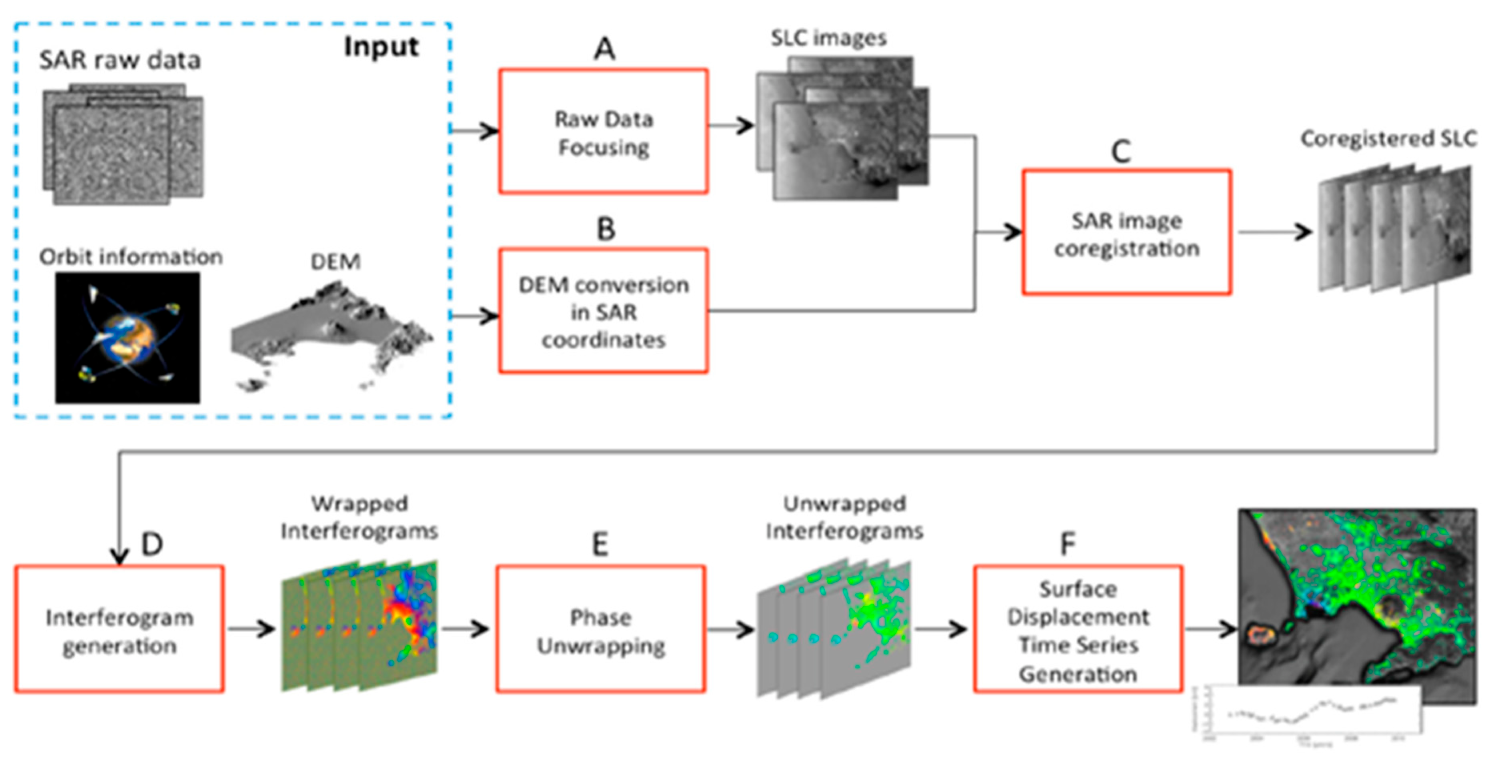
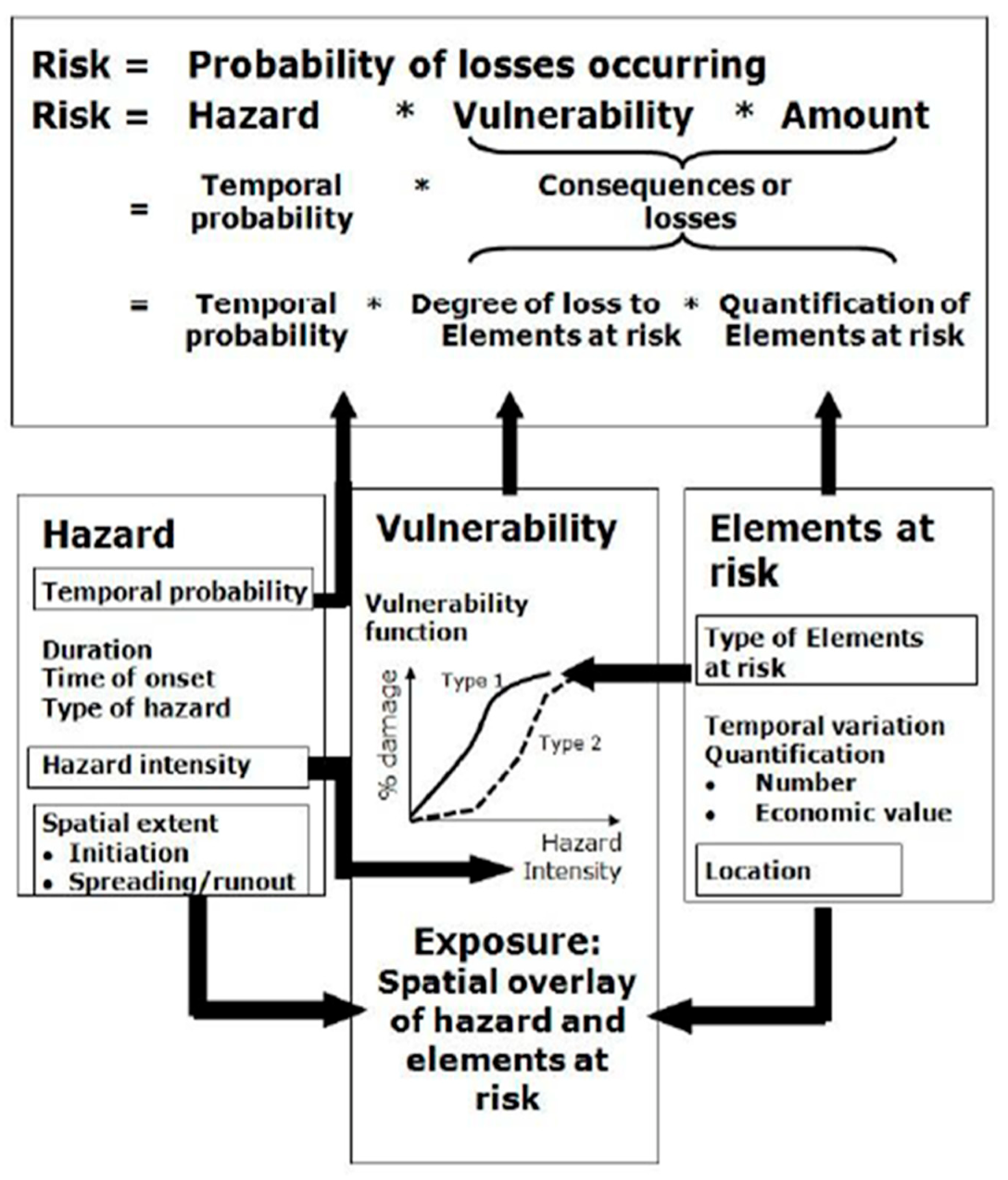
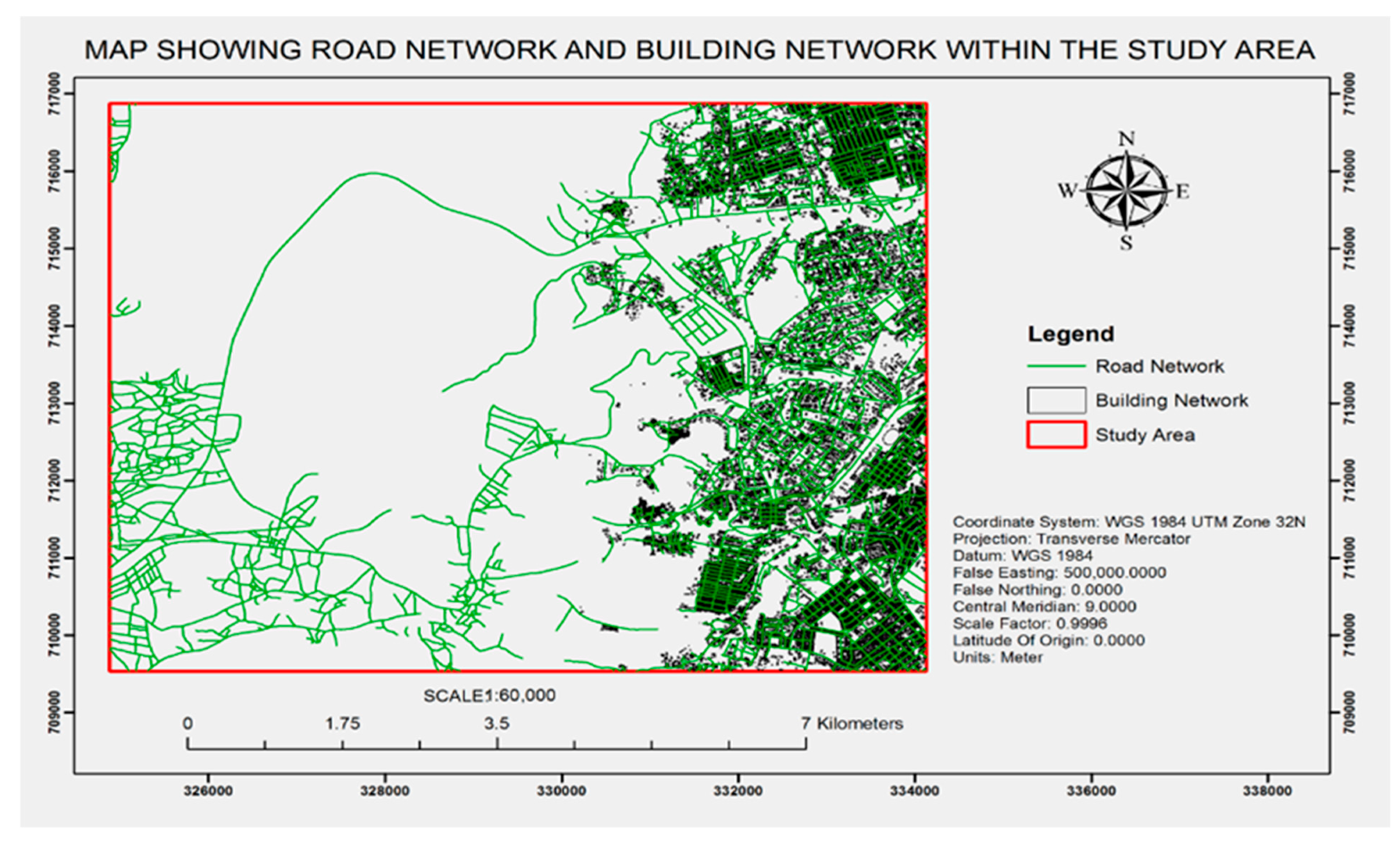
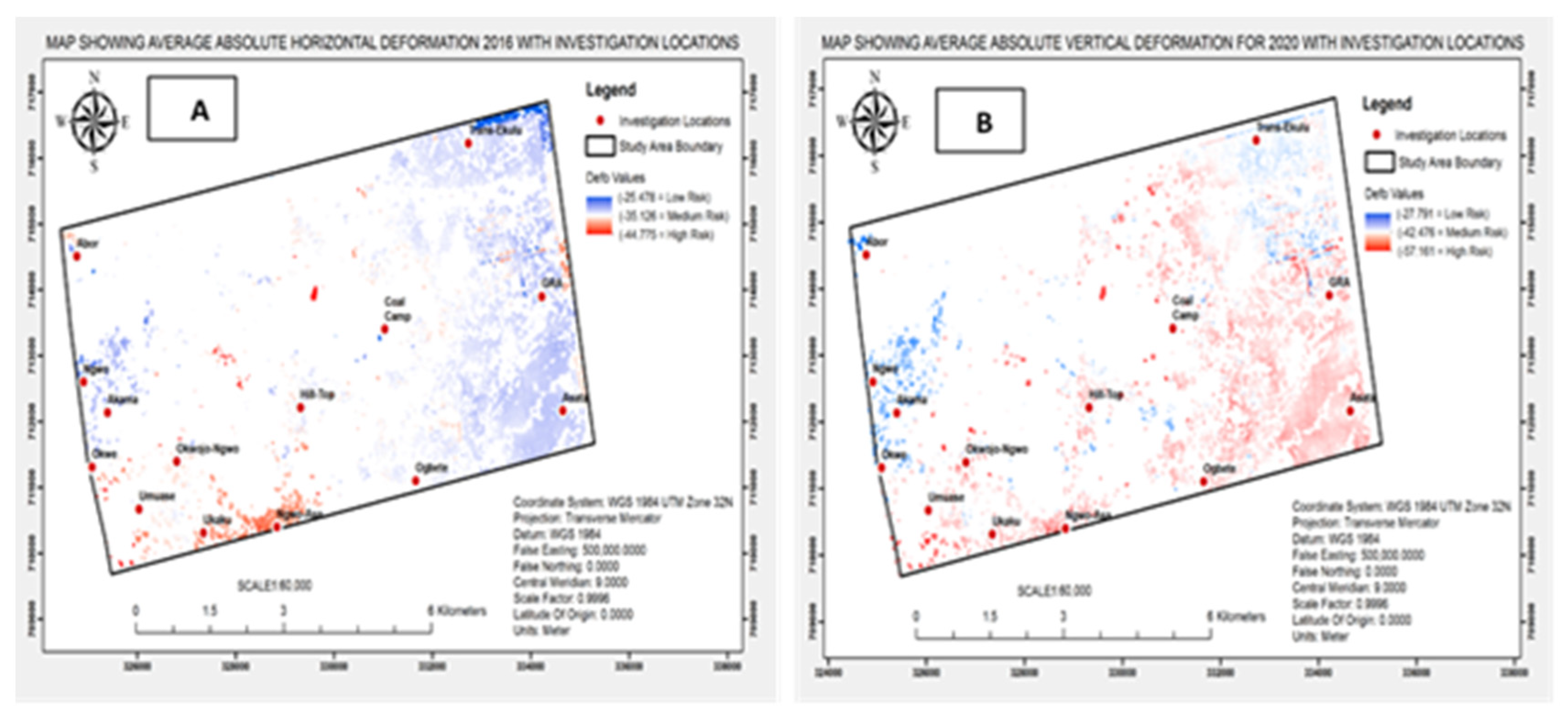
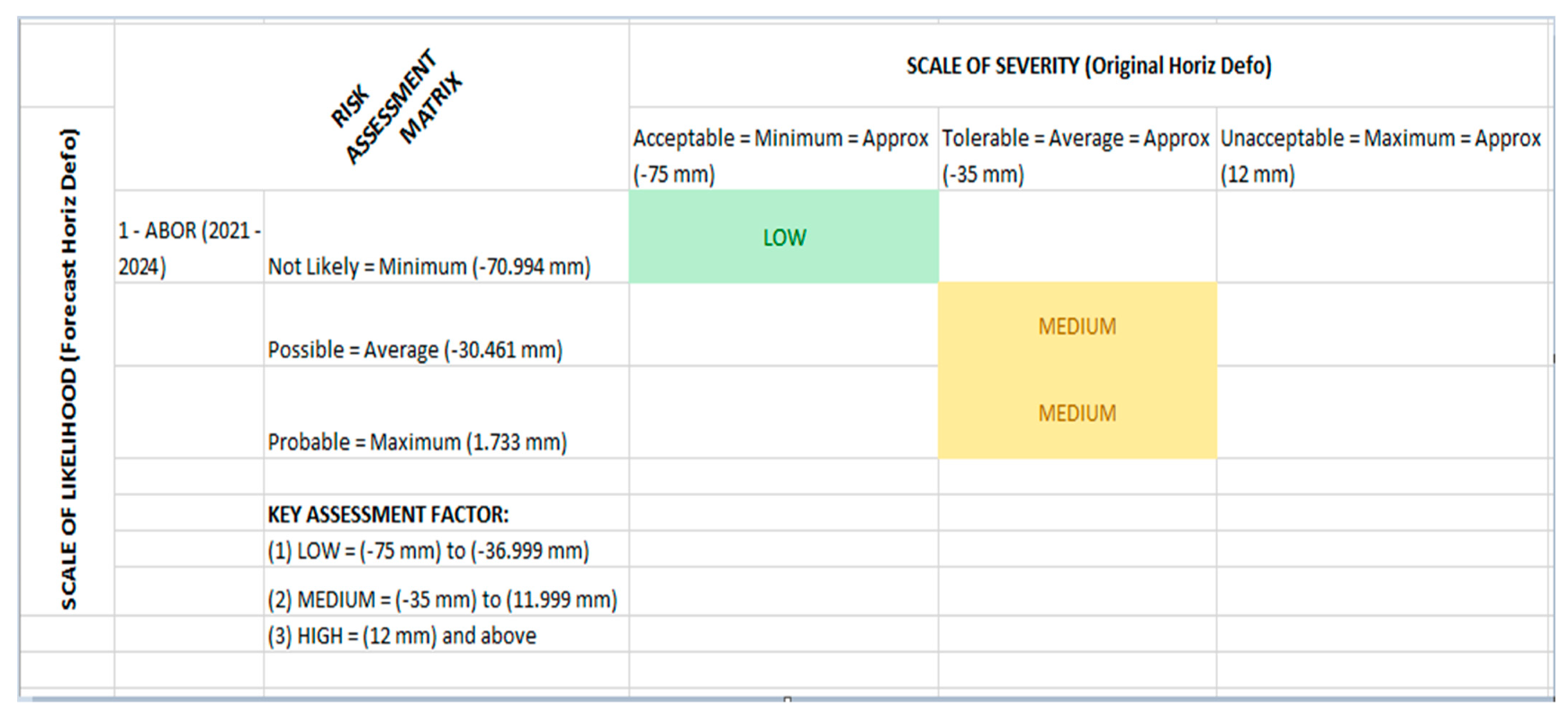

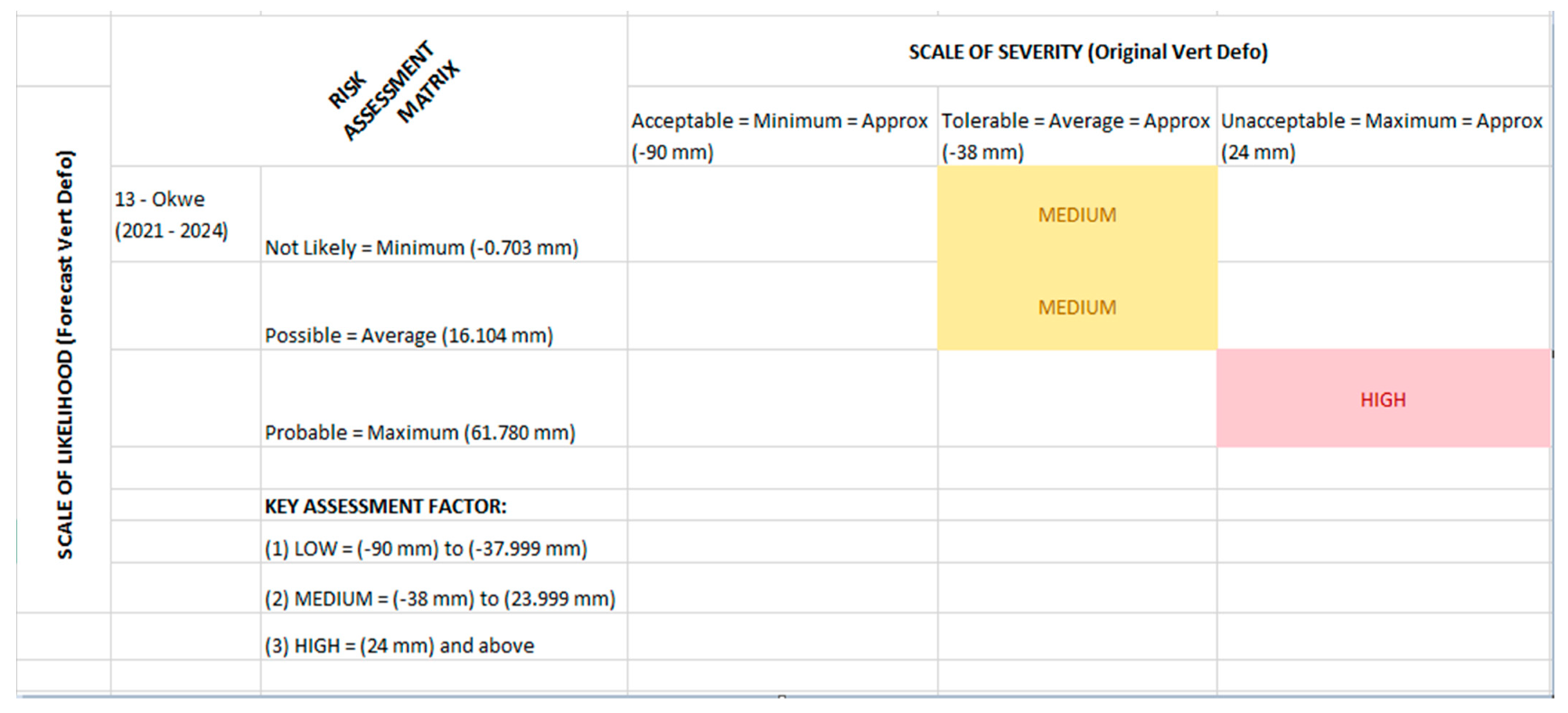
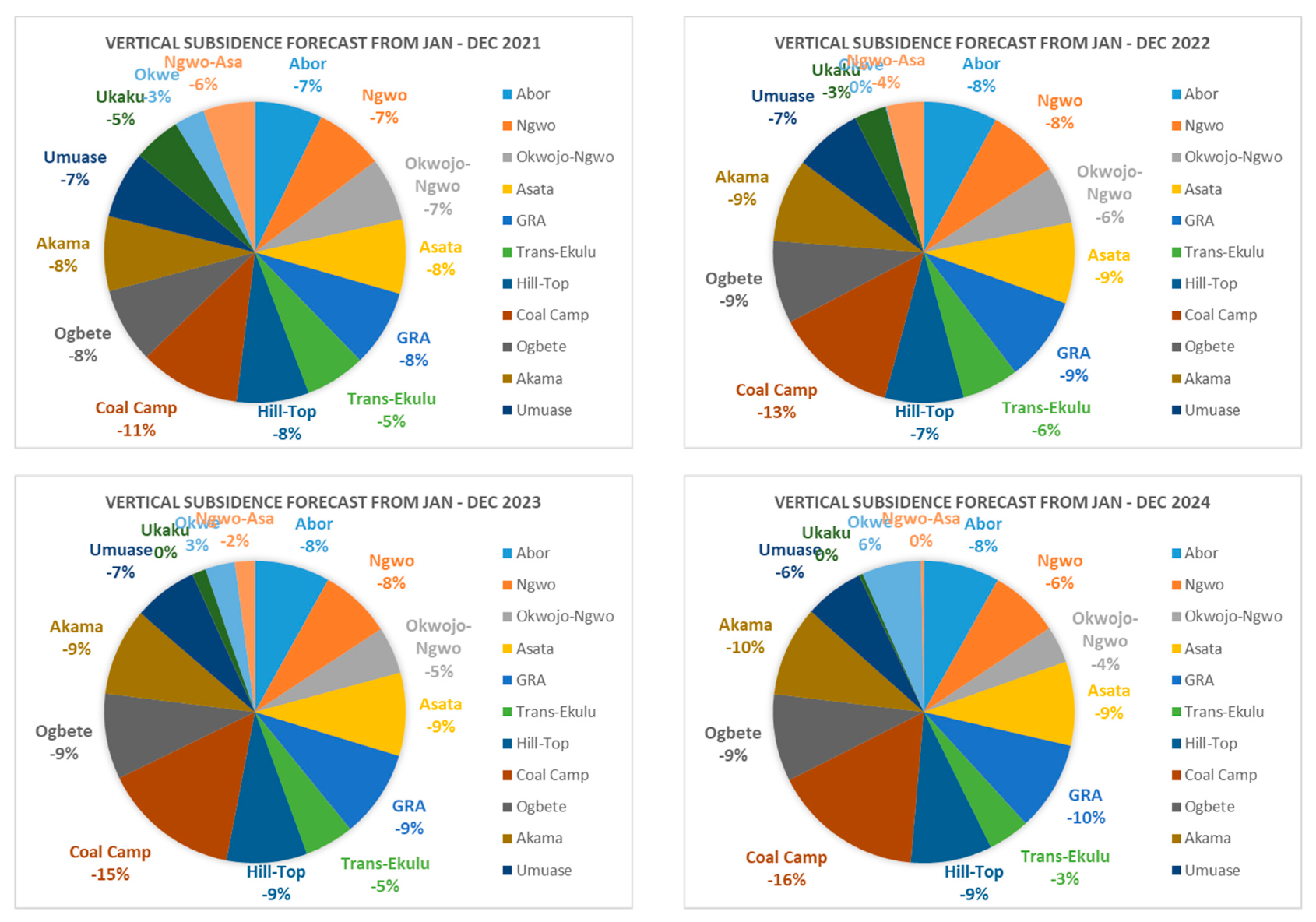
| S/N | Yearly Image of Study Area | Average Rate of Horizontal Deformation (mm) | ||
|---|---|---|---|---|
| 1 | Sentinel-1 SLC SAR 2016 | −25.487 = low | −35.126 = medium | −44.775 = high |
| 2 | Sentinel-1 SLC SAR 2017 | −20.893 = low | −33.072 = medium | −45.251 = high |
| 3 | Sentinel-1 SLC SAR 2018 | −27.596 = low | −37.660 = medium | −47.722 = high |
| 4 | Sentinel-1 SLC SAR 2019 | −24.636 = low | −37.778 = medium | −51.115 = high |
| 5 | Sentinel-1 SLC SAR 2020 | −28.134 = low | −39.539 = medium | −50.945 = high |
| S/N | Yearly Image of Study Area | Average Rate of Vertical Subsidence (mm) | ||
|---|---|---|---|---|
| 1 | Sentinel-1 SLC SAR 2016 | −24.532 = low | −36.922 = medium | −49.312 = high |
| 2 | Sentinel-1 SLC SAR 2017 | −18.665 = low | −34.308 = medium | −49.950 = high |
| 3 | Sentinel-1 SLC SAR 2018 | −28.008 = low | −40.927 = medium | −53.846 = high |
| 4 | Sentinel-1 SLC SAR 2019 | −26.821 = low | −43.785 = medium | −60.750 = high |
| 5 | Sentinel-1 SLC SAR 2020 | −27.791 = low | −42.476 = medium | −57.161 = high |
| S/N | Investigation Location | Risk Assessment Matrix | Elements at Risk | Consequence of Potential Hazard |
|---|---|---|---|---|
| 1 | Abor | Low–Medium | The main elements at risk of possible hazards include: 1. Population; 2. Properties (roads, buildings, utilities); 3. Economic activities (markets, schools, public offices, etc.); 4. Environmental degradation (pollution, waste discharge, etc.). | There is a likelihood of harmful consequences and losses which may arise through deaths, injuries, damage to properties and livelihoods, disruption of economic activity, and degradation of the environment. This may result from interactions between (natural, anthropogenic) hazards and vulnerable conditions within the area and time period. |
| 2 | Ngwo | Low–Medium | ||
| 3 | Okwojo-Ngwo | Medium–High | ||
| 4 | Asata | Low–Medium | ||
| 5 | GRA | Low–Medium | ||
| 6 | Trans-Ekulu | Low–Medium | ||
| 7 | Hill-Top | Medium–High | ||
| 8 | Coal Camp | Low–Medium | ||
| 9 | Ogbete | Low–Medium | ||
| 10 | Akama | Low–Medium | ||
| 11 | Umuase | Low–Medium | ||
| 12 | Ukaku | Medium–High | ||
| 13 | Okwe | Medium–High | ||
| 14 | Ngwo-Asa | Medium–High |
| S/N | Investigation Location | Risk Assessment Matrix | Elements at Risk | Consequence of Potential Hazard |
|---|---|---|---|---|
| 1 | Abor | Low–Medium | The main elements at risk of possible hazards include: 1. Population; 2. Properties (roads, buildings, utilities); 3. Economic activities (markets, schools, public offices, etc.); 4. Environmental degradation (pollution, waste discharge, etc.). | There is a likelihood of harmful consequences and losses which may arise through deaths, injuries, damage to properties and livelihoods, disruption of economic activity, and degradation of the environment. This may result from interactions between (natural, anthropogenic) hazards and vulnerable conditions within the area and time period. |
| 2 | Ngwo | Low–Medium | ||
| 3 | Okwojo-Ngwo | Low–Medium | ||
| 4 | Asata | Low–Medium | ||
| 5 | GRA | Low–Medium | ||
| 6 | Trans-Ekulu | Low–Medium | ||
| 7 | Hill-Top | Low–Medium | ||
| 8 | Coal Camp | Low–Medium | ||
| 9 | Ogbete | Low–Medium | ||
| 10 | Akama | Low–Medium | ||
| 11 | Umuase | Low–Medium | ||
| 12 | Ukaku | Medium | ||
| 13 | Okwe | Medium–High | ||
| 14 | Ngwo-Asa | Medium |
| Investigation Locations | Dimension of Vulnerability | Potential Damage (%) | Hazard Intensity (1–2) | Severity Score (None, Low, Medium, High, Critical) % | ||
|---|---|---|---|---|---|---|
| Average Horizontal Deformation | Average Vertical Subsidence | Average Horizontal Deformation | Average Vertical Subsidence | |||
| Abor | 1. Physical vulnerability impact 2. Social vulnerability impact 3. Institutional vulnerability impact. 4. Economic vulnerability impact. 5. Environmental vulnerability impact. 6. Cultural vulnerability impact. | −6% | −8% | 1 | 1 | Road—1.1% (Low) Building—1.1% (Low) Population Density—1.1% (Low) |
| Ngwo | −5% | −7% | 1 | 1 | Road—6.1% (Low) Building—1.5% (Low) Population Density—2% (Low) | |
| Okwojo-Ngwo | −5% | −5% | 1 | 2 | Road—3.9% (Low) Building—1.1% (Low) Population Density—1.6% (Low) | |
| Asata | −11% | −9% | 1 | 1 | Road—11.2% (Low) Building—22.5% (Low) Population Density—5.8% (Low) | |
| GRA | −10% | −9% | 1 | 1 | Road—11.8% (Low) Building—12.4% (Low) Population Density—5% (Low) | |
| Trans-Ekulu | −8% | −4% | 1 | 1 | Road—11% (Low) Building—13.6% (Low) Population Density—5.6% (Low) | |
| Hill-Top | −3% | −9% | 1 | 2 | Road—2.3% (Low) Building—1.4% (Low) Population Density—1.4% (Low) | |
| Coal Camp | −13% | −15% | 1 | 1 | Road—3.8% (Low) Building—5.5% (Low) Population—2.5% (Low) | |
| Ogbete | −10% | −9% | 1 | 1 | Road—7.9% (Low) Building—10.3% (Low) Population Density—2.1% (Low) | |
| Akama | −11% | −9% | 1 | 1 | Road—7.1% (Low) Building—1.6% (Low) Population Density—1.1% (Low) | |
| Umuase | −9% | −7% | 1 | 1 | Road—5.1% (Low) Building—1.3% (Low) Population—1.5% (Low) | |
| Ukaku | −2% | 0% | 2 | 2 | Road—3.5% (Low) Building—1.1% (Low) Population Density—1.1% (Low) | |
| Okwe | 4.5% | 4.5% | 2 | 2 | Road—4.1% (Low) Building—1.1% (Low) Population Density—1.1% (Low) | |
| Ngwo-Asa | −2% | −2% | 2 | 2 | Road—2.3% (Low) Building—1.2% (Low) Population Density—1.3% (Low) | |
Disclaimer/Publisher’s Note: The statements, opinions and data contained in all publications are solely those of the individual author(s) and contributor(s) and not of MDPI and/or the editor(s). MDPI and/or the editor(s) disclaim responsibility for any injury to people or property resulting from any ideas, methods, instructions or products referred to in the content. |
© 2023 by the authors. Licensee MDPI, Basel, Switzerland. This article is an open access article distributed under the terms and conditions of the Creative Commons Attribution (CC BY) license (https://creativecommons.org/licenses/by/4.0/).
Share and Cite
Nduji, N.N.; Madu, C.N.; Okafor, C.C.; Ezeoha, M.U. A Geo-Hazard Risk Assessment Technique for Analyzing Impacts of Surface Subsidence within Onyeama Mine, South East Nigeria. Land 2023, 12, 575. https://doi.org/10.3390/land12030575
Nduji NN, Madu CN, Okafor CC, Ezeoha MU. A Geo-Hazard Risk Assessment Technique for Analyzing Impacts of Surface Subsidence within Onyeama Mine, South East Nigeria. Land. 2023; 12(3):575. https://doi.org/10.3390/land12030575
Chicago/Turabian StyleNduji, Nixon N., Christian N. Madu, Chukwuebuka C. Okafor, and Martins U. Ezeoha. 2023. "A Geo-Hazard Risk Assessment Technique for Analyzing Impacts of Surface Subsidence within Onyeama Mine, South East Nigeria" Land 12, no. 3: 575. https://doi.org/10.3390/land12030575
APA StyleNduji, N. N., Madu, C. N., Okafor, C. C., & Ezeoha, M. U. (2023). A Geo-Hazard Risk Assessment Technique for Analyzing Impacts of Surface Subsidence within Onyeama Mine, South East Nigeria. Land, 12(3), 575. https://doi.org/10.3390/land12030575







